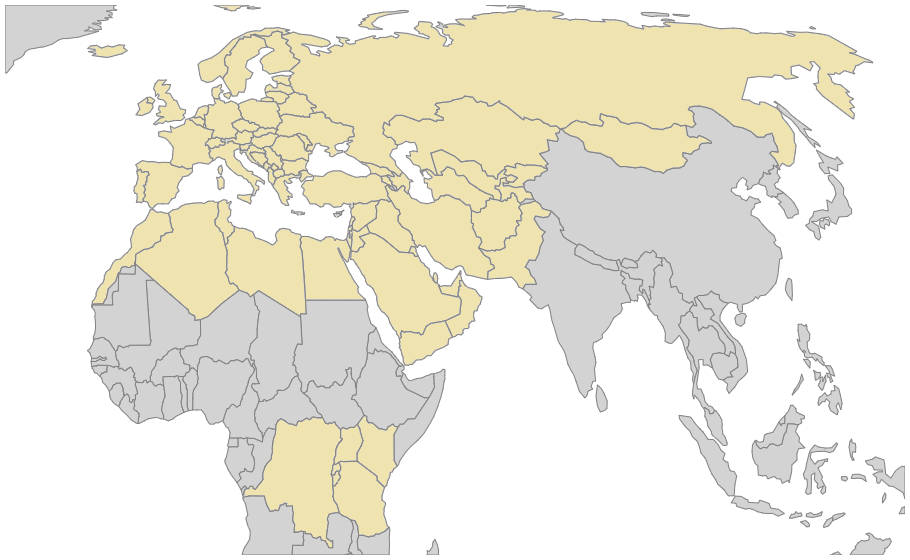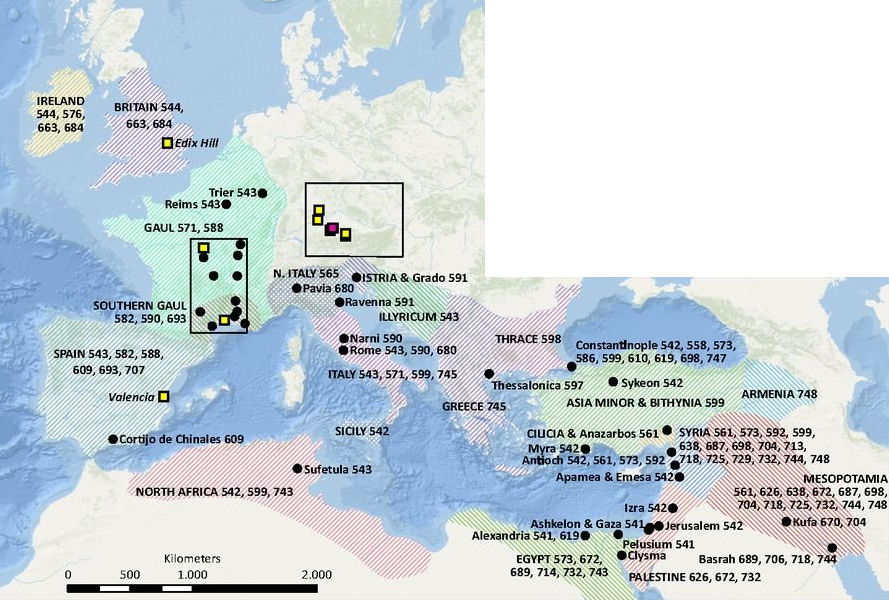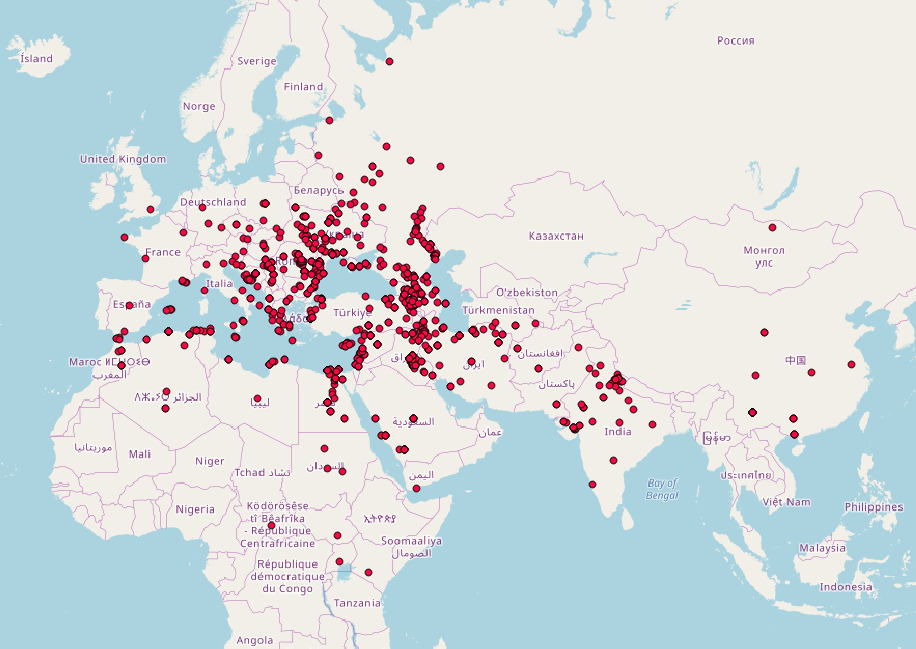How many people died of the plague?
One of the first queries that comes up when you google "how many people died of", is how many people died of the (black) plague. Unfortunately, pretty much every answer that you can find online is wrong.

ou will get plenty of answers when you search for the death toll of plague - there are answers on Wikipedia and on Encyclopedia Britannica. There are nice visualizations made by National Geographic and the Visual Capitalist, and many books and scientific publication on plague will list a death toll somewhere in their introduction.
But most of these sources are just parroting each other's numbers (BBC, Reuters, etc), and then get cited by Wikipedia as a credible source. And the most commonly returned answer by search engines is specific to the 1346-1351 Black Death epidemic in Europe.
That is not the question we asked!
How far could we get if we were interested in answering how many people died of the plague in total? To answer that, it helps if you split up the problem into the three plague pandemics, and the periods before and after the pandemics.
- (pre-pandemic period)
- The First Plague Pandemic from 541 AD - 750 AD (for Europe)
- (inter-pandemic period)
- The Second Plague Pandemic from 1338 - 18th century (for Europe)
- (inter-pandemic period)
- The Third Plague Pandemic from late 19th century - 1938 (worldwide)
- (post-pandemic period)
tl;dr. We end up with an estimate of ±1.4 billion people that died of the plague in total. There is a large amount of uncertainty in the geographic range and time frame of the early plague outbreaks, as well as demography of humankind in general.
Let's get started.
The Time before the Three Plague Pandemics
The first thing you need to know is that plague has been killing people for at least 5,000 years (Andrades, 2017). And when you move that far back in history it becomes extremely difficult to assess how many people lived, let alone how many people died of a particular disease. However, it does look like that 5,000 years ago plague was already wrecking havoc: remnants of the plague bacterium have been found across Eurasia, in a surprising large fraction of the corpses that were tested for the presence of ancient plague DNA.

In another post on this blog, I looked at the fraction of corpses that were tested and found positive for plague in ancient DNA studies that predate the First Plague pandemic, and conclude that a reasonable estimate for the plague-specific fraction of all-cause mortality is as high as 6% for the time period prior to the First Plague Pandemic. This is based on a total of 759 remains tested, and resampling the observations gives a 95% confidence interval of 3.7%-10.4%.
Using the 6% cause-specific mortality estimate for plague, we can leverage demography datasets like HYDE 3.2, and a rule of thumb that estimates an annual birth rate of 80 people per 1,000 people alive (or 60 people per 1,000 after 1 AD), as used in a blog post by the Population Reference Bureau on the world population, to get to a total number of people that died of plague.
That leaves two questions open. How far back in time do we assume plague killed 6% of all people, and across how large a geographic area? What you decide here matters quite a lot for any total estimate of pre-pandemic plague deaths.
For the time range, I picked 3,000 BC - 541 AD. Starting the counter at 3,000 BC is fairly conservative in terms of total death toll: the plague bacterium became a separate species somewhere between 35,000-80,000 years ago, splitting off from the ancestor it shares with Yersinia pseudotuberculosis (Rasmussen, 2015). But luckily, the number of people that lived before 3,000 BC isn't that large to begin with - the world population grew from about 2 million people, 50,000 years ago, to about 60 million people by 3,000 BC. Such a small population means that the impact of making a wrong decision here on the time range is not that large on the overall estimate.
For the geographic range, I took a broader view than just the regions where ancient plague has been discovered. I included all the countries in Eurasia west of the China-India axis, until solid aDNA evidence comes from East Asia. I also included the countries in Africa that border the Mediterranean, as that coastline has long been connected to Europe. In addition, I added a group of countries in Central Africa, because the phylogenetic analysis of one publication (Leulmi et. al, 2014) suggests that plague has been there for at least 3,000 years.

Andrades Valtueña et al. (2017) ‘The Stone Age Plague and Its Persistence in Eurasia’, Current biology: CB, 27(23), pp. 3683–3691.e8.
Rasmussen, S. et al. (2015) ‘Early Divergent Strains of Yersinia pestis in Eurasia 5,000 Years Ago’, Cell, 163(3), pp. 571–582.
Leulmi, H. et al. (2014) ‘Detection of Rickettsia felis, Rickettsia typhi, Bartonella Species and Yersinia pestis in Fleas (Siphonaptera) from Africa’, PLoS neglected tropical diseases, 8(10), p. e3152.
If you take that 6% cause-specific mortality, a time frame of 3,000 BC - 541 AD, and the above geographic range, and run the numbers, you get a rough approximation of 537 million people that died of plague prior to the three plague pandemics.
The largest uncertainty in that number of 537 million is the geographic uncertainty. Our estimate of 537 million people reduces to 200 million if we limit ourselves to the countries that confirmed plague in aDNA samples, and grows to 1.53 billion people if we include triples if we include the countries that make up the China-India axis (e.g. China, India, Nepal, Bangladesh, Bhutan). Likewise, we have a lot of demographic uncertainty: the upper and lower bound estimates for population sizes from HYDE 3.2 change our estimate to anywhere between 127 million - 947 million people!
The impact of including a longer time frame, say up until 10,000 BC (the furthest back that HYDE 3.2 goes) has a smaller impact: it increases our estimate from 537 million to 680 million. That is because the further back in time you go, the smaller the total human population was (see this PRB blog post on global population size).
If we combine all those uncertainties, and include the 95% confidence interval of our 6%, we get a huge range of possible pre-pandemic plague deaths, from just 29 million to 5.67 billion people. More ancient DNA research will help narrow down that range, but for now we stick with our best-guess estimate of 537 million pre-pandemic plague deaths.
The First Plague Pandemic
Fast forward to the year 541 AD in Pelusium, Egypt. The plague outbreak in Pelusium is typically named as the start of the First Plague Pandemic in Europe, which lasted until 750 AD. The plague may have well spread into Africa and Central Asia as well - we just have very little historical information about plague outside of Europe for that period. Ancient DNA has been recovered from victims of the plague from dozens of sites, confirming that this pandemic was indeed a cause by the plague.
There is a very lively scientific discussion ongoing on how deadly this first plague pandemic actually was (Mordechai 2019, Sarris 2022), and it is worth reading both sides to get a feeling for the challenges of tallying up the dead in historic times.
The range cited by Mordechai is 15-100 million people that died of the plague in Europe between 541 AD and 750 AD. If we look at the fraction of plague-positive human remains sampled from sites from the First Plague Pandemic that weren't obviously mass-burial sites, we see that Keller et al. (2019) lists 16 positives out of 105 samples. That 15% is a marked increase compared to the 6% we saw in pre-pandemic times.
If we use that 15% percentage as the cause-specific mortality, we get an estimate of 63 million people for the part of Europe that Marcel Keller considered in his study (Keller et al, 2019).

That 63 million would turn into 129 million for the geographic region we used for our pre-pandemic period (map shown earlier), and into 539 million if we also included the population of India and China.
Dr. Farid Ghassemlou provided me with some evidence that a large portion of the cholera outbreaks in medieval Iran actually were plague outbreaks, based on his work for the Medical Encyclopedia of Islam and Iran, which makes me favor the 129 million option.
In terms of demographic uncertainty, our number of 129 million ranges from 56 million to 201 million for the lower and upper estimates from HYDE.
We leave the additional uncertainty that comes with the small sample size aside, for now.
Mordechai, L. et al. (2019) ‘The Justinianic Plague: An inconsequential pandemic?’, Proceedings of the National Academy of Sciences of the United States of America, 116(51), pp. 25546–25554.
Sarris, P. (2022) ‘New Approaches to the “Plague of Justinian’, Past & present, 254(1), pp. 315–346.
In between the First and Second Pandemic
It has been something of an entrenched idea that the first plague pandemic ended in 750, and that the Black Death in 1346 was the start of the Second Plague Pandemic. This automatically meant that outbreaks between 750 AD and 1346 AD were not considered in the context of possibly being plague. That idea is changing now with a recent publication on plague in Baghdad, Iraq in 1258 AD, and also fits with the reports from Farid Ghassemlou on Iran.
We need to decide how to treat this period between the First and Second Plague Pandemic. From a Europe-centric perspective, I think we can largely trust that Europe was largely free from plague, but for the region outside of Europe it is probably better to assume the 6% cause-specific mortality that we saw for plague prior to the First Plague Pandemic.
If we trust Europe to be largely free from plague, but stick to our map of plague existing in Russia, the Middle East, Central Asia and Central Africa at a lower intensity, we get a HYDE-based estimate of 76 million people that died between 750 AD and 1346 AD, mostly outside of Europe.
The Second Plague Pandemic
The Second Plague Pandemic was brutal. Besides wiping out half of Europe to start with (the usual estimate is 30-60%), the disease also kept recurring at lower city-wide mortality levels. There are a number of datasets out there that help us get a handle on the death toll. First, Daniel Curtis and Joris Roossen (2017) looked at the period of 1349-1450 in the Low Countries, where they documented the deaths per year during plague years and non-plague years. Similarly, we have the London bills of Mortality from 1540-1680, recently re-analysed by David Earn (2020). The reported cause-specific fraction of mortality by plague is in the range of 23-44%!
These numbers are high, and have a substantial error margin. For example, diagnosing the cause of death during plague outbreaks was outsourced to unskilled labour, not by medical doctors, and both London and the Low Countries had exceptionally high population densities. So maybe this 23-44% is a high-end estimate when you look across all of Europe.
Based on genetic data, there are two papers - Eaton 2023, who looks at Denmark, and Keller 2023, who looks across Europe. Where Keller finds 12.4% cause-specific mortality, based on 11 positive out of 85 samples (outside of mortality events), Eaton finds a much lower 4.4%, based on 13 positives out of 298 samples.
Both aDNA-based percentages are considerably lower than the percentages based on the historic records of London and the Low Countries. There is a multitude of reasons possible for the differences, which are beyond the scope of this blog post. For lack of a better answer, I will use the 15% cause-specific mortality rate that we also found for the First Plague Pandemic. It is a bit higher than the aDNA-based percentages, but not as high as the records-based numbers for the high-population centers of London and the Low Countries.
If we once again use the geographic range that includes central Africa but leaves out Southern and Eastern Asia, a 15% all-cause mortality translates to 548 million people that died of plague during the Second Plague Pandemic, with a demographic uncertainty range of 391-706 million people.
Curtis, D.R. and Roosen, J. (2017) ‘The sex-selective impact of the Black Death and recurring plagues in the Southern Netherlands, 1349-1450’, American journal of physical anthropology, 164(2), pp. 246–259
12
Earn, D.J.D. et al. (2020) ‘Acceleration of plague outbreaks in the second pandemic’, Proceedings of the National Academy of Sciences of the United States of America, 117(44), pp. 27703–27711.
Eaton, K. et al. (2023) ‘Emergence, continuity, and evolution of Yersinia pestis throughout medieval and early modern Denmark’, Current biology: CB, 33(6), pp. 1147–1152.e5.
Keller, M. et al. (2023) ‘A Refined Phylochronology of the Second Plague Pandemic in Western Eurasia’, bioRxiv.
In between the Second and Third Pandemics
When did the Second Plague Pandemic end? The outbreaks that are typically considered to represent the end of the Second Pandemic (the plague of Marseille in 1720-1722 or the plague in Moscow in 1770-1772), are only so from a rather narrow western-Europe perspective.
When you take older compendiums of plague, such as that of Georg Sticker, you will find many records of plague present from Eastern Europe to India between 1723 to 1893. With the Third plague pandemic starting in Southwest China in 1788 or 1855, depending on who you ask, the two pandemics overlap seamlessly in time and space!

We can again take the same geographic range as we did for the period between the first and second pandemic (i.e., our first geographic map, but without Europe), and assume an inter-pandemic all-cause mortality of 10%. That will result in about 50 million plague victims.
The Third Plague Pandemic
The Third Pandemic can best be split up continent by continent, as different continents had very different death tolls. For details on those estimates, see my guest post on lrhmatters.com, but what is evident is that by far the largest death-toll was in India and Southern China, for a total of about 21 million people.

After the Third Pandemic
There is not really a well-defined end of the Third Pandemic, but looking at various papers from different continents (Bramanti, Kuguler, Sun, Neerincxk, Jones), plague stopped being an epidemic disease around the 1950's, with case numbers returning globally to close to 0. Plague kept flaring up in outbreaks spilling over from local wildlife reservoirs after the '50s, but there is nothing that signals that plague was still spreading by human agency, like it did during the pandemics.
WHO used to have a dataset online of plague cases per year and per country, but no longer so. So I compiled the summary reports published by the WHO, to get a total (reported!) number of cases and deaths from 1954 until 2018. These reports contain some copy-paste errors and typos (the totals in the report seem to have been added up by hand, and sometimes a row is shifted one entry), but by browsing the WER archives and by doing some comparative work between WER reports, I removed most of these errors. You can download the excel file with the cleaned-up WHO data here.
The global total for the period of 65 years from 1954 to 2018 sums up to 1,149,952 cases and 9874 deaths, or about 150 deaths per year.
How many people died in total of the Plague?
So, if we have to give a single number of the total number of people that died of the plague, we come to the following list.
- 537 million in the period 3,000 BC to 451 AD
- 129 million during the 1st Plague Pandemic (451 AD - 750 AD)
- 76 million between the 1st and 2nd Plague Pandemic, outside of Europe
- 548 million people during the 2nd Plague Pandemic (1349-1750)
- 50 million people between the 2nd and 3rd Plague Pandemic, outside of Europe
- 21 million people during the 3rd Plague Pandemic (1893-1938)
And very few people after the end of the 3rd Plague Pandemic. So, we come to a total of ±1.4 billion people, but with a huge amount of uncertainty around some of these numbers. That uncertainty comes from demographic uncertainty (how many people were alive), geographic uncertainty (how far did the plague strike), and uncertainty in the cause-specific mortality rate of plague, which for most of this blog post was based on 10's of plague-positive skeletons found in low-100's of people sampled across a wide geographic area and time frame.
Revisiting those earlier estimates..
The National Geographic's estimate was 100 million people during the years 541-542 AD and an additional 50 million during the Black Death (1346-1350). The Visual Capitalist gave an estimate of 30-50 million for the plague of 541-542, and 200 million(!) for the Black Death.
Given our estimate of 129 million during the whole 1st Plague pandemic and across a larger geographic range, that 100 million from the National Geographic looks like a large over-estimate. The 50 million for the period 1346-1350 looks quite high, as depending on what definition of Europe you use, we had about 77 million people living in Europe by 1300 (HYDE), about 54 million by 1400 (HYDE, post- Black Death). Here I use this definition of Europe, minus the Russian Federation. If you presume that Europe's population got a a bit higher still after 1300, then, using a 30-60% cause-specific mortality estimate we are looking at 10-20 million deaths for Europe's Black Death, far lower than the 50 or 200 million estimates!
Either way, I hope you enjoyed this blog post!